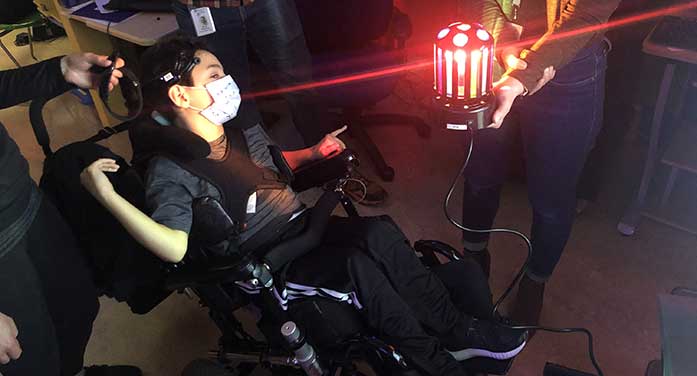Imagine children with severe mobility issues being able to move their wheelchairs with their minds. That’s the idea behind a new brain-computer interface being developed by researchers at the Universities of Alberta and Calgary.
Think2Switch is designed to be a simple and nearly universal bridge connecting brain signals to switch-enabled devices such as a wheelchair, light or electric toy. It’s still in the early stages of development but early tests have been promising.
The device is the inaugural winner of the ST Innovations Challenge. It was developed in a partnership between the U of A’s Assistive Technology Lab, the U of C’s Pediatric Brain-Computer Interface Program (BCI 4 Kids) and the Ontario-based company Ideas for Independent Living.
“Our brains are designed in a really lucky way in that the motor cortex and the activation of imagined movement can be read directly from electrodes just placed on your scalp,” said Eli Kinney-Lang, lead scientist at BCI 4 Kids Calgary.
Brain-computer interface, or BCI, has emerged as a promising new way to connect people with assistive technologies. But it can be complicated and often doesn’t work easily with existing devices, especially for children where research has been limited.
“There’s a big gap in the BCI world around children, particularly in connecting to the devices kids might actually want to use,” said Kim Adams, associate professor in the U of A’s Faculty of Rehabilitation Medicine and director of the Assistive Technology Lab.
“For kids with limited mobility, being able to use their brain to turn on a toy is going to be a really valuable beginner tool,” said Adams. “From that toy, they might progress to controlling a game or moving a power wheelchair, and from there, they might progress to more control with the brain signals. I think it will slowly open up the world to them.”
“Right now, BCI headsets are cumbersome to use and are really geared towards engineers, researchers and clinicians,” Kinney-Lang added. “If you’re a parent who’s looking for something like that right now for your child, you would need a huge amount of technical knowledge to be able to run and connect it to the adaptive devices you’re used to.”
Thanks to the $120,000 prize from the ST Innovations Challenge and a $30,000 contribution from Campus Alberta Neuroscience, the team will refine and improve the device with input from families and early testers over the next few months. From there, they plan to expand to a larger trial in the coming year in partnership with other BCI teams across Canada and the United States, including the I CAN BCI program at the Glenrose Rehabilitation Hospital in Edmonton, with which Adams works closely.
“I think one of the great things about this group is that we share a common mindset, which sometimes doesn’t happen in these kinds of partnerships,” said Bill Johnson, president of IdeasFIL, the company that designed and manufactured the Think2Switch prototypes. “Our reason for doing this is the same across the board: we all want to take this great idea and turn it into a solution for people.”
Smart Technology Innovations is a U of A non-profit centre that develops health technology. It’s the business arm of the Sensory Motor Adaptive Rehabilitation Technology (SMART) Network. The centre works to remove barriers to developing health technology and offers health innovation companies, entrepreneurs and innovators in Canada customized preclinical services, engineering and connection to clinical expertise. It’s led by Vivian Mushahwar, professor in the Division of Physical Medicine & Rehabilitation, director of the SMART Network and Canada Research Chair in Functional Restoration.
The Innovations Challenge was launched in May to encourage participants to create an innovative solution to a major neuro-musculoskeletal impairment. Teams are required to include a clinical partner, a commercial partner and an academic partner, with at least one of those being a member of the SMART Network.
The members of the Think2Switch team agreed that approach was key to their success.
“This competition was a unique way for us to move things forward,” said Adam Kirton, a pediatric neurologist at the Alberta Children’s Hospital and director of BCI 4 Kids. “Pulling the three pieces of clinical, academic and industry together is very different than any grant I’ve had before. I think that’s great and I think that’s the direction we need to go.”
“It was a game-changer,” added Johnson. “In the early stages, we were self-funding the project, but that was very limiting. With this funding, we’re able to really push this forward.”
| By Ryan O’Byrne
Submitted by the University of Alberta’s Folio online magazine. The University of Alberta is a Troy Media Editorial Content Provider Partner.
© Troy Media
Troy Media is an editorial content provider to media outlets and its own hosted community news outlets across Canada.



